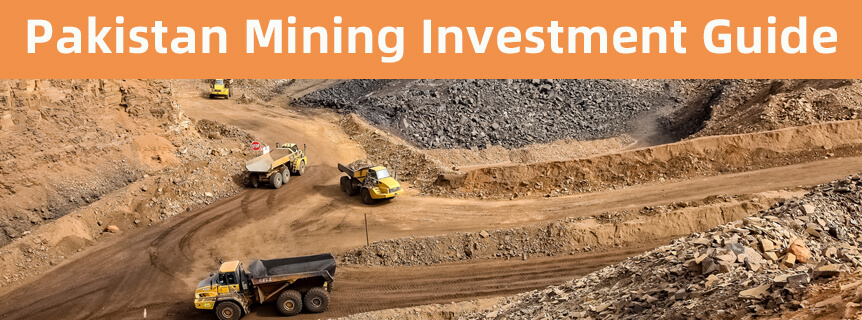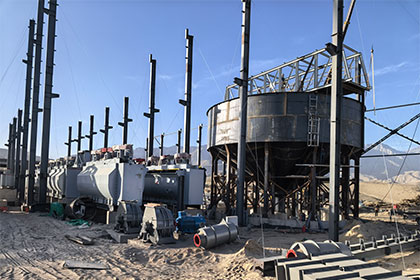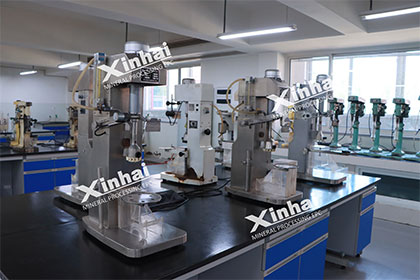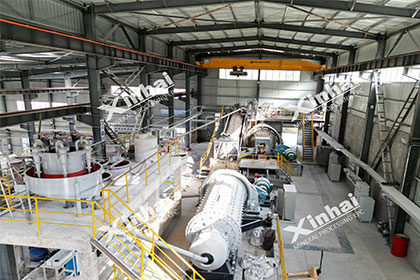Pakistan Mining Investment Guide
 Shirley
Shirley
 Aug 27, 2022
Aug 27, 2022
 2112
2112
If you want to know more details about equipment, solutions, etc, please click the button below for free consultation, or leave your requirements!

Pakistan is relatively rich in mineral resources. Currently, 44 kinds of minerals have been found in the country, and more than 25 kinds of minerals have proven reserves. Before we talked about the South African mining investment guide. This article will introduce the Pakistan mining investment guide.
01 Pakistan Overview
BackPakistan is located in the northwest of the South Asian subcontinent, bordering the Arabian Sea to the south, with a coastline of 840 kilometers, and the Karakoram and Himalayas to the north. It is bordered by India, China, Afghanistan and Iran on the east, north and west sides respectively. Most of Pakistan is in the subtropical zone, the climate is generally hot and dry, and the precipitation is relatively rare. The areas with annual precipitation less than 250 mm account for more than three-quarters of the country's total area.
Pakistan is a multi-ethnic country, of which 63% are Punjabis, 18% are Sindhi, 11% are Pashtuns, and 4% are Balochistan. According to the constitution, Pakistan's state religion is Islam, and Muslims account for 95% of the country's total population, of which 90% of the Muslim population are Sunnis. In addition, there are Hinduism and Christianity, but only 5% of the country's population.
02 Distribution of Mineral Resources
BackPakistan is relatively rich in mineral resources. At present, 44 kinds of minerals have been found in the country, and more than 25 kinds of minerals have proven reserves. The main minerals known in Pakistan are oil, natural gas, coal, chromite, copper, iron ore, gold, lead, zinc, bauxite, gemstones, gypsum, phosphate rock, barite, kaolin and salt, etc.
Coal Mine
Pakistan is rich in coal resources. According to the estimates of the Geological Survey of Pakistan (GSP), the coal resources are about 185 billion tons, mainly distributed in Sindh Province, as well as Balochistan, Punjab and Northwest Frontier Province. Among them, 184 billion tons are in Sindh, accounting for 99.5% of the national total, 217 million tons are in Balochistan, 235 million tons are in Punjab, and 90 million tons are in North West Frontier Province. The largest coalfield is the Thar coalfield in Sindh province, with reserves of 175.5 billion tons. Followed by the Sonda-Thatta coalfield in the same province, with reserves of 3.7 billion tons. Lakhra coal field with reserves of 1.3 billion tons.
Copper Mine
Pakistan's copper ore reserves are about 500 million tons, mainly concentrated in the Scientology, RekoDiq and western porphyry complexes in the Chagai region of western Balochistan Province. Also carried out in the most detail. The ore reserves of the Scientology Copper Mine are about 413 million tons, and the average grade of copper is 0.45%. In addition, it also contains a large amount of gold and silver resources. The Rektick area is rich in porphyry copper and copper-gold deposits, and there are at least 16 known porphyry-type copper-gold mineralization zones. Copper resources exceed 10 million tons, gold is about 622 tons, and copper grades are 0.3% to 0.7%. The Western Porphyry Complex has a 5km long vein with total resources of 10.287 million pounds of copper and 9.1 million ounces of gold.
Iron Mine
The origin of iron ore in Pakistan is sedimentary, volcanic, and hydrothermal. The ore grade is generally not high, but the ore reserves are rich, which is said to be more than 600 million tons. The deposits are mainly distributed in Punjab and Balochistan, with a small amount in the other two provinces. The largest deposit is the Kalabagh Chichali iron ore in Punjab Province, with an ore reserve of about 350 million tons, containing 30% to 34% of iron and 21% to 24% of silicon. The second largest iron ore is the Dilband iron ore in Balochistan Province. The ore reserves are about 200 million tons, the iron content is 35% to 40%, and the silicon content is 20%. The mine is located 640 kilometers north of Karachi. It belongs to sedimentary type, mainly composed of hematite and limonite. The third important deposit is the Nokkundi iron ore in Balochistan, with an ore reserve of 50 million tons and an iron content of 45% to 49%. There are also some small iron mines, such as Langrial and Pe-ZU in North West Frontier Province, Chilghazi in Balochistan and RakniMunn in Punjab. The reserves range from 6.5 million tons to 27.9 million tons. These mines are generally considered to be of little mining value due to reserves, mineral quality and geographical location.
Lead-zinc Mine
Pakistan's lead-zinc ore resources are more than 50 million tons, mainly distributed in Duda, Sumai, Gonggar, and Dunge. Among them, the Duda lead-zinc mine in southern Balochistan is the most valuable and famous. The mine was discovered in 1988, the lead-zinc ore vein is 1100m long, the thickness of the ore layer is more than 6.5m, and the resource is about 50 million tons. After detailed exploration, the proven ore reserves are 14.31 million tons, with an average grade of 8.6% zinc and 3.2% lead. 1.5 Chromite Pakistani chromite is mainly distributed in Balochistan and Northwest Frontier Province, among which, the MusilimBagh mining area in Balochistan is estimated to have an ore reserve of 4 million tons. Next is the Malakan mining area in the Northwest Frontier Province, with ore reserves of about 677,000 tons. The Ko-histan mining area of Kohistan has reserves of about 372,000 tons.
Gold Mine
Pakistan has great potential for gold resources, and the important areas are the northern mountainous areas and the western Chagai area of Balochistan. In the northern mountainous area, gold resources are distributed irregularly along the extension of the Karakoram Mountains. Thirteen irregular gold-bearing zones have been identified in the Chitra| region of the North West Frontier Province. In addition, nine gold-bearing sites have been identified in the DIR, SWAT and MALAKAND areas. In Balochistan, there are a lot of gold resources co-existing with copper mines, such as the Scientology copper-gold mine and the Rektik copper-gold mine, the latter of which has an estimated gold resource of more than 600t.
03 Mining Management
BackThe Pakistani government first issued a national mineral policy in September 1995, which included mineral rights protection and incentives for exploration. In recent years, the government has continued to revise and supplement existing policies. In general, it mainly includes the following eight points:
1. Small-scale investments in the mining development sector with a capital amount of less than Rs 300 crore will be limited to Pakistani nationals.
2. Promote mergers or acquisitions of small-scale mining enterprises.
3. The Geological Data Center of Pakistan (GDCP) is responsible for the collection, storage, updating and maintenance of national geological data.
4. The federal government and local governments will provide preferential policies for mineral exploration for enterprises that make promotional investments in priority development of minerals or priority development areas.
5. There are 4 types of mining rights, namely visit license, exploration license, mining area reservation license and mining license.
Visit permit: apply for preliminary mineral exploration within a specified area (100-10000km2) for a period of one year. The license is non-exclusive and cannot be extended after expiration, but the license holder has priority to obtain a 10% exploration license. The license is issued by the Ministry of Petroleum and Natural Resources of Pakistan or by local authorities.
Exploration Permit: Exploration within a specific area of 1000km2 for a period of not more than 3 years. When the permit expires, two extensions can be applied (no more than 3 years per year), and each extension application must return half of the initial exploration area. In addition, no transfer of an exploration license to a third party is allowed within the first two years of holding the license. The license can be issued by the Pakistan Geological Survey or by the local mining authority, depending on the type of mineral being explored.
Mining Retention License: Between exploration licenses and mining licenses. It allows companies to evaluate the economic viability of mining areas. The retention period is 2 years, and a 1-year extension can be applied for. This license is generally issued by the Ministry of Petroleum and Natural Resources of Pakistan.
Mining license: within an area of not more than 250km2, the application period for a mining license can be up to 30 years, which can be extended for 10 years.
All permits for metallic minerals are generally issued by the Ministry of Petroleum and Natural Resources, while non-metallic minerals (such as coal, marble, and quartz, etc.) are issued by the provincial government. The application for exploration permit and exploration permit will be reviewed within 120 days. Applications for a mine retention permit will be decided within 180 days. For mining leases, a decision is made within 60 days. All decisions on the grant, revocation, transfer and confiscation of mining rights will be immediately published by the local government, and the mining company has the right to apply for international arbitration. Mining licenses can be transferred to third parties with the approval of the licensing authority. Foreign companies can directly apply for and be granted exploration licenses without local registration, whereas mining licenses must be registered locally before they can be obtained.
6. Businesses can build smelters without government permission.
7. There are no additional local taxes other than mining royalties.
8. Export of mined minerals is exempt from sales tax.
Over time, Pakistan faces a series of new challenges in order to increase the contribution of the domestic mining industry in the process of domestic economic development and competitiveness in the international investment market. Pakistan made a series of revisions to its mining policy in 2013. The main objectives of the new mining policy (NMP-2013) are:
1. Increase the contribution of mining to domestic economic development by attracting more investment
2. To make the domestic mining industry competitive in the international investment market by creating a stable and enabling environment
3. Ensure smooth functioning and effective coordination between federal and local agencies
4. Ensure smooth functioning and effective negotiation between the federal government and local agencies in both the implementation of mining industry policies and regulations and the regulation of production
5. Ensure sustainable exploration, development and production of mineral resources in Pakistan. Small-scale mining and local private companies are encouraged to get involved.
04 Investment Analysis
BackFavorable factors
(1) Great market potential. With a population of 208 million, Pakistan is the sixth most populous country in the world, with a per capita GDP of US$1,560 in the 2017/18 fiscal year, and a huge market potential.
(2) The geographical location is superior. Pakistan is located in South Asia, bordering the Arabian Sea in the south and bordering India, China, Afghanistan and Iran in the east, north and west respectively. It is a hub connecting South Asia, Central Asia and West Asia (Middle East). The market has a wide range of radiation, which can radiate to regions such as the Middle East and Central Asia, and has close trade relations with the above-mentioned regions.
(3) The government and the private sector strongly welcome investment. The Pakistani government has implemented economic reforms, economic liberalization and privatization, and formulated a relatively loose and liberal investment policy, hoping to enhance its competitiveness in attracting foreign investment by improving the policy system, providing preferential treatment and good investment services.
(4) In terms of regional preferential policies, the Pakistani government encourages foreign enterprises to invest and set up factories in export processing zones and special economic zones, and the policies for each industrial zone are relatively flexible.
Unfavorable factors
(1) The economy is not yet developed. Pakistan's economy is dominated by agriculture, but the share of agriculture in GDP has been declining in recent years, and the share of industry has increased year by year.
(2) There are still many problems and bottlenecks in Pakistan's investment environment, such as policy continuity needs to be strengthened. Infrastructure construction is relatively backward. Inflation remains high and operating costs continue to rise. The political situation is turbulent from time to time, and the security situation is more severe.
 +86 183 3575 8886
+86 183 3575 8886 pinklaurabao@gmail.com
pinklaurabao@gmail.com




 Message
Message Chat Now
Chat Now

















